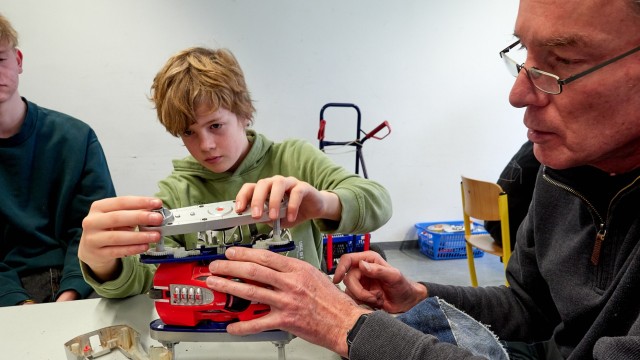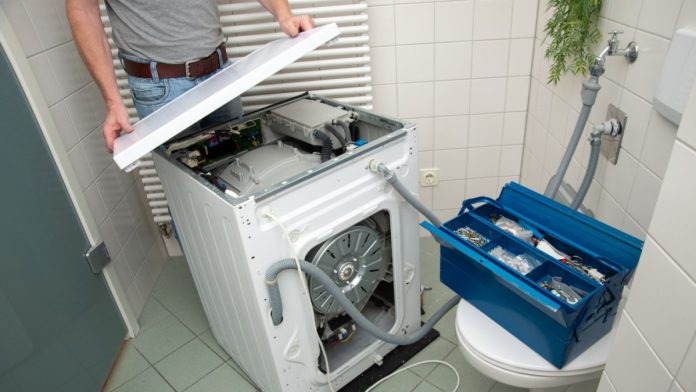People found an envelope in their mailbox around 40,000 times last year. Inside: a strap with a plastic part, less than ten centimeters long, comparatively simple but important. The chest strap on a children's backpack ensures that the little ones don't carry so much lunch boxes and water bottles. This strap adorns tens of thousands of backpacks that hang on coat hooks in German kindergartens every day – sometimes as elephants, sometimes as tigers. And the figures suggest that the belt is lost tens of thousands of times a year. The company “Fond of”, which is behind the backpacks, sends the straps upon request, easily and free of charge. In doing so, it anticipates a development that will affect many companies in the coming years.
At the European level, the right to repair is already underway; the EU directive is expected to come into force in early summer. The traffic light government also announced a right to repairs in its coalition agreement. According to the Ministry of the Environment, the exact schedule is still unclear. One thing is certain: If EU law soon becomes national legislation, various existing and future regulations will intertwine, including a new eco-design directive. In the future, customers will have, among other things, the right to a repair from the manufacturer, even if the warranty period has expired. Companies must also post repair instructions and pricing information online and keep spare parts available long-term and affordably. Initially, this does not apply to all products, but only to laptops, tablets and smartphones and so-called white goods, especially larger household appliances such as refrigerators or dishwashers.
The company “Fond of” sends spare parts for its children's backpacks free of charge upon customer request.
(Photo: Fond of)
The right to repair is still a “small, toothless tiger,” says Marion Jungbluth from the Federal Association of Consumer Organizations (VZBV). Many small devices in particular are not covered by the new directive. Jungbluth cites coffee machines as examples. Furniture items are also excluded.
35 million tons of waste are products that could actually be repaired
In the medium term, however, the legal requirements could definitely have an impact and lead to a rethink. More and more companies are already focusing on providing their customers with as many spare parts as possible. This applies both to companies affected by the new regulation and to representatives of other industries. The number of repair-friendly providers is continually growing, says consumer advocate Jungbluth. The water filter manufacturer Brita and the household appliance manufacturer Miele are two examples of many. Or “Fond of”, the company that produces children’s backpacks and also sells shoes, drinking bottles and other products for children. Some offer the individual parts for money, others, like the water filter manufacturer Brita, even send them to customers for free. There are sustainability considerations and marketing reasons behind this.
According to an analysis by the EU Commission, 35 million tons of waste are created every year simply by disposing of products that could be repaired. Because everything is becoming more and more affordable, customers have learned to simply buy a new electric toothbrush at the drugstore when the old one no longer works. At the same time, the number of shops that specialize in repair services has fallen over the years – because there was too little demand, but also because there is a lack of skilled workers. In addition, many products have long been built in such a way that they are difficult to repair or spare parts are expensive. During a recent market check, consumer advice centers discovered how strongly spare parts prices fluctuate: For example, a detergent container for washing machines was available for both 5.95 euros and 72.60 euros.
Basically – and of course with exceptions – one rule applies: the higher quality and therefore often more expensive the products, the more often companies offer repairs. Like “Fond of”. A children's backpack costs between 45 and 75 euros, the company's school bags are even more expensive. For both product groups, the manufacturer's warranty is increased to four years. Another example: Miele. For decades, the household appliance manufacturer has had a reputation among customers for charging high prices but producing particularly reliable and repairable devices. In its guarantee offers, the company also goes far beyond legal requirements.
Standing out from the competition – in the future this will primarily be possible with service
The effort that companies put into this is enormous. At the water filter manufacturer Brita, for example, the filter change indicator is often ordered as a spare part. But it is not always clear from the first message what exactly the customer is looking for. “We usually ask for photos in order to be able to better identify the different products and spare parts if consumers are not sure,” said a spokesman from the day-to-day work of the customer service department. The effort for storage, handling and shipping is “significant”.
Miele keeps more than 72,000 different spare parts in stock and they remain available for at least 15 years after a series has expired. The kitchen appliance manufacturer Krups, which belongs to the French SEB group, stores around eight million spare parts so that they can be made available quickly. And at the children's product manufacturer Fond of, an average of six employees and one seamstress work on repair and spare parts requests. Because the effort is so great, there was at times the idea of making the service subject to a fee. “We could definitely earn additional money this way in addition to our core business,” says Eilin Merten, who heads customer management. So far, however, the decision has been made against it, primarily for marketing reasons.
Customers in this country say that it has become more important to them how repairable products are. According to the EU analysis, three out of four respondents would rather have an item repaired than buy it new. In so-called repair cafés, people all over the country try to repair all sorts of objects themselves, from old toasters to broken keyboards. Almost 20,000 people have subscribed to Miele's YouTube channel, where you can see explanatory videos about repairs. The Brita spokesman also says that customers “ask much more often for spare parts and also expect that a company can respond to these requests accordingly.” Eilin Merten from Fond of reports countless emails from customers who are surprised at how easily they can get spare parts. Often, she says, sustainability is important to customers. In times of rising prices, financial considerations are likely to come into play: European consumers pay twelve billion euros a year for products that they have to replace instead of being able to repair them.

Workshops, like the one here at a high school in Bavaria, in which young people are made aware that repairing devices is a sustainable option, have been available more and more in recent years. A scene of repair cafés and maker laboratories has also emerged in Germany.
(Photo: Peter Hinz-Rosin/Photography Peter Hinz-Rosin)
For manufacturers like Fond of, a spare parts service is an investment in the future – and a competitive advantage if the products themselves are similar. “In the future, good service will become a differentiating factor, especially for manufacturers of high-quality products,” says Merten. Consumer advocate Jungbluth also expects this. Your association is calling for an index that helps customers see how repairable a company's products are. Only in this way, according to Jungbluth, would real comparability be possible. She even thinks it would be best if there was a requirement for manufacturers to state the durability of an item – and to link the warranty period for repairs to this. “This would offer companies the opportunity to stand out through longevity and higher quality,” says Jungbluth.
A future option for good spare parts service: 3D printing
Of course, another way to get more spare parts would often be even easier. “We live in a digital society, the 3D printer is not entirely new,” says the consumer advocate. In their opinion, the ability to reprint parts of a product from a file has not been used often enough. This is also where the new EU directive comes into play. Repairs with spare parts that are created in the 3D printer or that do not come from the original manufacturer should be simplified. Product designer Astrid Lorenzen has been working on repair options through 3D printing for years. She has high hopes for a German version of EU law. In addition to the legislature, she also sees a duty on manufacturers who could act now. “My understanding is that part of having a device is being able to repair it,” she says. This is still only the case in exceptional cases.
The companies Krups and Miele are such exceptions. Miele offers printing instructions for downloading on its website – not for spare parts, but for additional products such as a bubble vacuum cleaner attachment. Krups has been producing spare parts using 3D printers for eight years. The company prints 500 different parts in a repair center in France. The original idea was to be able to supply parts that were no longer produced using 3D printing. Another advantage has now come into focus: saving storage capacity.
For 3D printing expert Lorenzen, it is no coincidence that Krups in particular is taking innovative approaches: In France, 3D spare parts data and financial incentives are part of the legislation. From Lorenzen's point of view, there is still a long way to go before the new cap from the 3D printer becomes standard in this country. On the one hand, it is unclear who is liable if someone is injured because a reprinted part is installed in a device. On the other hand, “the legal hurdles for designs and patents are still very high,” says Lorenzen. In what they see as an ideal future, these questions would have to be clarified and companies would always have to supply the print files for spare parts when they sell a product. “The design may also have to be changed in some cases so that spare parts can be reprinted,” says Lorenzen. This is also part of the EU plans: a simplified design.
The question remains open as to how it should be checked whether all companies are adhering to the future applicable regulations. Consumer advice centers in particular consider this aspect to be crucial. However, by the time this is clarified, many people who wear animal backpacks will have long since switched to a school bag. After all, there is a replacement belt for that too.



